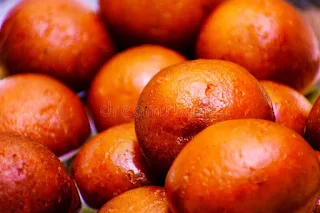I used to mix flour (maida) for mixing in the paneer or chhana for binding purpose before frying pantua balls.
Suddenly, I got confused. I saw the Pantua recipe in Bela Dey's recipe book. There instead of maida, sabeda or chikoo was mentioned as the binding ingredient instead of flour or maida.
Then in another recipe book, semolina or suji was the binding ingredient.
Then I started enquiring whether the mixing of flour or maida with the paneer or chhana was correct or not. One sweet maker of a sweet shop informed me that they also use flour or maida - not chikoo (sabeda) or semolina. Then I was convinced that I was also correct. But I did not include soda in my Pantua ingredient. I do not like to add soda. But soda is used in the flour or maida while mixing paneer or chhana.
 |
| Pantua * |
Full cream Cow Milk 1 litre
(You will get approximately 150 grams paneer or chhana out of 1 litre milk)
Lemon juice 1 tablespoon
100 grams Khoya
3 1/2 tbsp All Purpose Flour
A pinch of Salt
1/4 tsp Ghee
A handful of black cardamom
Ghee or Oil for frying
2 cups sugar
1 1/2 cups water
HOW TO MAKE PANTUA
In a big vessel, pour the entire milk and put this on the gas flame. Stir occasionally.
When the milk starts boiling, add the lemon juice (dilute with 1 tablespoon water) and stir well. Alternatively you can use curd or vinegar instead of lemon juice.
The moment you add the lemon juice in the hot milk, within a second, the milk starts separating the water from the milk.
Do not boil further once the water separates completely. Take out the vessel from the flame.
Strain this with the help of a clean thin cloth or muslin cloth.
Squeeze off the water completely. Do not over squeeze as the moisture in paneer or chhana will be lost.
Keep the cloth containing paneer or chhana on a plate or thali. Over this keep the grinding stone as a weight to squeeze out the excess water from the paneer or chhana.
Alternatively, you can also hang the cloth containing paneer or chhana for 1 hour making sure the water is drained out completely, yet remain the moisture of the paneer or chhana.
In a kadai or another heavy bottomed pan, add the water and sugar to make the sugar syrup.
Let the water boil. Once the sugar gets dissolved, add milk in it to remove the impurities of sugar.
Stir the syrup. As the froth appears on the surface of the sugar syrup, take it out in a bowl with the help of a spatula. After removing the froth, sugar syrup will become very clean.
Stir occasionally and let it continue to boil till the water becomes a syrupy one string consistency. Take out from the flame.
In a big thali or plate, take the paneer or chhana. Rub this nicely with your palms so that all the grains of the paneer or chhana become soft. Add flour, ghee, a pinch salt and mix this thoroughly.
Knead this until the dough is smooth enough, not extremely sticky, firm but soft.
Remove the black cardamom seeds from the pods and keep them ready. Grate the khowa and mash them. Make tiny balls of the khowa.
Now take very small portion of the dough on your left hand palm. Flatten this. Insert a tiny khowa ball and one cardamom seed and seal the dough.
Roll this lightly to make a nice round shape. Ensure that no cracks are formed on the pantua balls. Complete making all the pantua balls. Keep aside.
In a kadai, add ghee or oil for deep frying.
Heat the ghee or oil.
Turn the flame to medium. Start adding the pantua balls in batches.
When one side of the pantua balls turn brown, turn them around to fry the other side. Fry all sides evenly.
Once the pantua balls turn nice brown colour, take them out of the ghee or oil. Soak them in the prepared sugar syrup for one hour.
After one hour, Pantua will be ready to eat.
You can keep them longer to absorb more syrup and become even more soft.
Note : If you do not want to make chhana or paneer at your home, just buy fresh chhana or paneer from the market.
Comments
Post a Comment